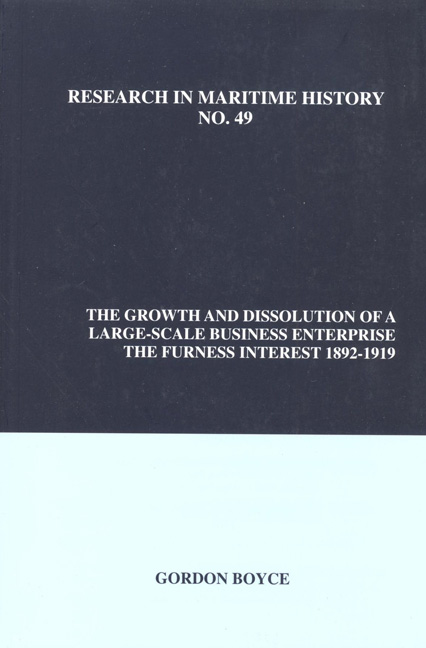Book contents
- Frontmatter
- Table of Contents
- About the Author
- Acknowledgements
- Figures and Tables
- Introduction
- Chapter 1 Furness' Shipping Services: Growth by Organic Means in the 1880s
- Chapter 2 The 1890s: Furness Withy's Expansion by Acquisition and Promotion
- Chapter 3 Diversification into the Industrial Sector, 1895-1901
- Chapter 4 Trouble on the Transatlantic Route: The Formation of the IMM and Furness' Response
- Chapter 5 The Growth of Shipping Services, 1902-1909
- Chapter 6 Industrial Operations and Performance, 1900-1914
- Chapter 7 The Growth of the Shipping Interests, 1910-1919
- Chapter 8 Structure
- Chapter 9 Finance
- Chapter 10 Holding Company Investment Activities and Intermediary Operations
- Chapter 11 Personnel
- Chapter 12 Furness
- Chapter 13 Dissolution
- Appendix 1 Development of the Combined Fleet, 1900-1919
- Appendix 2a Patterns of Ownership: The Furness Group, 1919
- Appendix 2b Reorganization of Branch Offices and Superintending Departments, 1911-1912
- Appendix 3a Fluctuations in Freights, Profits, Tonnage Afloat and Merchant Shipping Output
- Appendix 3b Output of Merchant Tonnage (Excluding Warships), 1892-1913
- Appendix 3c Fluctuations in the Price of a 7500-ton Cargo Steamer, 1898-1913
- Appendix 4 Development of the Furness Group: Principal Promotions, Acquisitions and Divestments, 1880-1919
- Appendix 5 Northern Allies and Maritime Associates
- Appendix 6 Contemporary Accounting Law and Conventions, 1845-1914
- Appendix 7 Lord Furness' Movements, 1899-1912
- Bibliography
Chapter 5 - The Growth of Shipping Services, 1902-1909
- Frontmatter
- Table of Contents
- About the Author
- Acknowledgements
- Figures and Tables
- Introduction
- Chapter 1 Furness' Shipping Services: Growth by Organic Means in the 1880s
- Chapter 2 The 1890s: Furness Withy's Expansion by Acquisition and Promotion
- Chapter 3 Diversification into the Industrial Sector, 1895-1901
- Chapter 4 Trouble on the Transatlantic Route: The Formation of the IMM and Furness' Response
- Chapter 5 The Growth of Shipping Services, 1902-1909
- Chapter 6 Industrial Operations and Performance, 1900-1914
- Chapter 7 The Growth of the Shipping Interests, 1910-1919
- Chapter 8 Structure
- Chapter 9 Finance
- Chapter 10 Holding Company Investment Activities and Intermediary Operations
- Chapter 11 Personnel
- Chapter 12 Furness
- Chapter 13 Dissolution
- Appendix 1 Development of the Combined Fleet, 1900-1919
- Appendix 2a Patterns of Ownership: The Furness Group, 1919
- Appendix 2b Reorganization of Branch Offices and Superintending Departments, 1911-1912
- Appendix 3a Fluctuations in Freights, Profits, Tonnage Afloat and Merchant Shipping Output
- Appendix 3b Output of Merchant Tonnage (Excluding Warships), 1892-1913
- Appendix 3c Fluctuations in the Price of a 7500-ton Cargo Steamer, 1898-1913
- Appendix 4 Development of the Furness Group: Principal Promotions, Acquisitions and Divestments, 1880-1919
- Appendix 5 Northern Allies and Maritime Associates
- Appendix 6 Contemporary Accounting Law and Conventions, 1845-1914
- Appendix 7 Lord Furness' Movements, 1899-1912
- Bibliography
Summary
In 1909, the Group served almost the same transatlantic liner routes as it did at the end of 1901. During the intervening years, the associated companies increasingly deployed their vessels in other trades that offered greater scope for profitable development. The Group varied the direction in which it expanded after 1901 in response to a fundamental change in the disposition of Britain's overseas trade and in reaction to increased competition on the North Atlantic. Moreover, the pattern of growth exhibited by the enterprise's shipping interests also changed as a result of its new links with heavy industry and ancillary businesses. This chapter charts the Group's expansion from 1902 to 1909 in the context of unfolding environmental conditions and shifts in the composition of the enterprise's resources.
Trends in Trade, Freight Rates, the Supply of Tonnage and Profits
In 1901, the United Kingdom's trade with the United States entered a period of stagnation. Although the value of the goods exchanged between the two nations rose from £179 million in 1901 to £192 million in 1907, a financial crisis in the US during the autumn of 1907 cut short the improvement, and by 1909 the value of Anglo-American trade had fallen back to £178 million. Trade between the two became static primarily because American exports to Britain declined as domestic consumption absorbed a larger proportion of total American production. Indeed, it was not until 1913 that the value of American exports to Britain regained the 1901 level. Consequently, Britain diversified its sources of supplies, especially foodstuffs, to Canada and Argentina. The value of Britain's trade with the Dominion rose from £30 to £44 million between 1901 and 1909, while the value of goods exchanged with Argentina increased by over 150 percent, from £19 million to £52 million, during the same period.
Although the value and volume of the UK's total overseas trade continued to expand after 1901, that year was marked by a sharp decline in freight rates from a peak of 112 in 1900 to ninety, as measured by Cairncross’ index, while the rates on outbound coal shipments - a relevant indicator for the tramp market - plummeted from just over ten shillings per ton to about 6.75 shillings (also see appendix 3).
- Type
- Chapter
- Information
- The Growth and Dissolution of a Large-Scale Business EnterpriseThe Furness Interest, 1892-1919, pp. 107 - 142Publisher: Liverpool University PressPrint publication year: 2012



